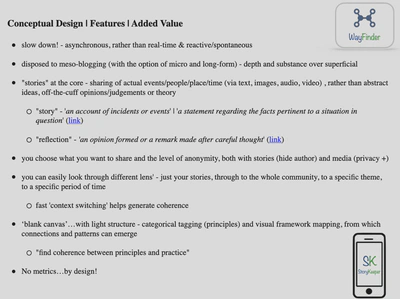Escaping The Dark Forest

As Maggie Appleton posted recently…
The Dark Forest theory of the web points to the increasingly life-like but life-less state of being online. Most open & publicly available spaces on the web are overrun with bots, advertisers, trolls, data scrapers, clickbait & algorithmically manipulated junk
https://maggieappleton.com/ai-dark-forest
I am seeking to create an alternative space, with the intention to support societal-scale transformation through small-scale action learning and experimentation.
Recognising The Dark Forest platforms were not going to support this aspiration, two years ago these were the founding ideas for an alternative online platform …

…and they continued to evolve:

Here is a presentation on the core concepts - https://wayfinders.network/blog/concept-feature-overview/
The Action Learning loop is particularly important to understand. As the animation below depicts, we cycle through a process of…
- people exploring & experimenting with new ways of being, seeing & doing (“wayfinders”)
- capturing & sharing their stories & reflections of those experiences
- collective sensemaking
- …informing action
The key idea here is we need to both “act to learn, and learn to act”. Also, the “output” of our sensemaking is not a blog post or published research paper* ; instead sensemaking is about orienting us towards wise action (applied practice).
* a paper that will be locked behind a monopolistic paywall, read by few and translated into practice by…nobody if history is any guide.
How do we scale this?
Very differently from what most organisations and governing bodies believe and attempt(!) - essentially top-down, one-size fits all. A global to local approach.
Instead, action learning operates best on a small/local scale, then through sharing & “signposting” becomes increasingly known/connected to others such that it propagates through self-organising networks.
There is a critical role for hosts/curators to share and signpost using hashtags, visual frameworks and other features of the platform. In doing so they help weave the network.
Infrastructure
The WayFinder Platform acts as “enabling infrastructure”.
Cassie Robinson has recently posted about a range of Imagination Infrastructures that are desperately needed - here are three that feel particularly resonant with the philosophy and motivations for the WayFinder Platform as a form of infrastructure…
Infrastructure for sense-making because what gets imagined needs collectively interpreting and translating
Relational infrastructure because we need people and communities taking part and becoming the practitioners themselves, who grow their capacity to imagine together over time and draw on that to shape their futures.
Archive infrastructure because gathering the content of people’s collective imagination over time, and archiving it well, will mean it can be drawn on over time, again and again. For me this is one of the ways that collective wisdom and perpetual participation in a community could be developed and how to avoid multiple one-off engagements, deliberations or worse still, ‘consultations.’
I particularly love Cassie’s last remark about developing collective wisdom and perpetual participation and avoiding the dreaded ‘consultations’ (this is the MO of the business-as-usual scaling approaches mentioned above 🥱)
Actually, I think that is a good message (principle?) to end on - “participation trumps consultation”, and we can create dynamic online tools and platforms for this
…that can also rescue us from The Dark Forest!
Get in touch - info [at] wayfinders.network